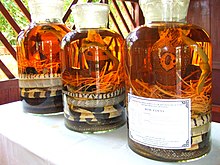Snake brandy
Snake brandy or snake wine ( Vietnamese rượu rắn ; Chinese 蛇 酒 shéjiǔ ) is an alcoholic drink with the peculiarity that the body of a snake is in the bottle . Poisonous snakes are preferred , but the snake venom is denatured by the alcohol .
Snake brandy was first made in Vietnam . The drink can now be found in large parts of Southeast Asia as far as South China . The snake venom is said to have healing properties for almost every disease in these areas. It should also help with erectile dysfunction. However, many of these claims are promotionally exaggerated or fictitious. The import of snake wine is prohibited in many countries. Poisonous snakes such as cobras , kraits and others are mostly under species protection and are therefore not allowed to be imported.
There are two types of snake schnapps: One involves placing the body of a dead snake in a bottle of rice wine . Usually there are other small snakes, turtles , insects or even small birds in the bottle . The liquid with the snake is stored for a few months.
The second variant is a mixture of rice wine with body secretions from a snake. Snake blood is usually used for this, but in other cases the wine is mixed with secretions from the snake's gallbladder . The brandy is called tonic drunk from small cups.
In 1999, at a pharmacist's in Phong Nha (Central Vietnam) , German biologists discovered a previously scientifically completely unknown species of snake in a snake liquor bottle, which they called the three-horned pit viper because of its characteristic appearance .
Habushu is a snake brandy on the Ryūkyū Islands in southern Japan . A Habu snake ( Protobothrops flavoviridis ), an endemic species of vipers, is used for this .
Web links
Individual evidence
- ↑ Thomas Ziegler: Research into biodiversity in the Vietnam project of the Cologne Zoo: The amphibians and reptiles of Phong Nha-Ke Bang. Journal of the Cologne Zoo, issue 4, 2004, pp. 147–171

